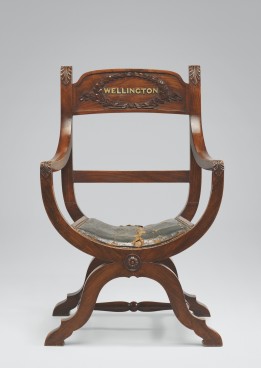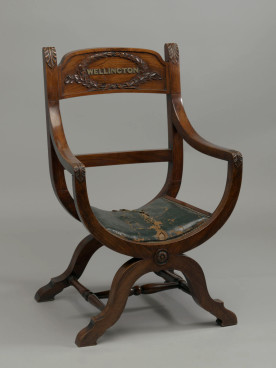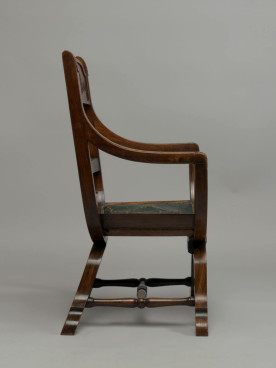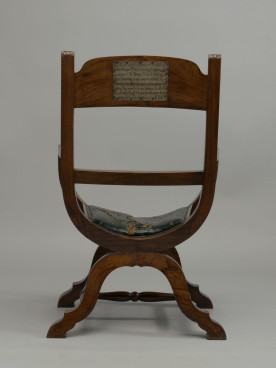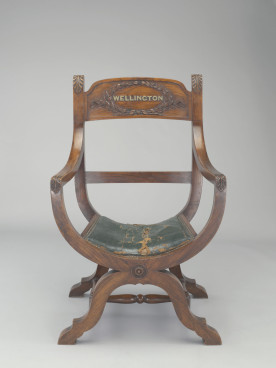Armchair, c.1820–30
Elm with original leather and
brass mounted lettering
This chair is one of four different chairs made from the elm tree beside which Arthur Wellesley, the Duke of Wellington, stood during the battle of Waterloo (1815). The chair was possibly made by Thomas Chippendale Junior (1749–1822), for Edward Vernon Utterson (1777–1856), whose initials appear after an inscription on the plaque on the reverse of the back.
Adam Bowett Catalogue 12/05/2013
Description
An arm chair, circa 1820, of ‘antique’ X-frame form, the top rail with a carved laurel wreath and the name ‘Wellington’ in brass letters, with a close-nailed green leather seat.
Dimensions
H: 38 ” (97cm) Seat height: 13 ” (33 cm) W: 24 ¼ ” ( 61 ½ cm) D: 19 ½ ” (50cm)
Designer / Maker
Possibly made by Thomas Chippendale Junior (1749–1822)
Materials
Brass, leather, various upholstery materials
Dating Criteria
The ‘Waterloo elm’ was felled in 1818 and the wood acquired by John Children (1777-1852) in that year. Most artefacts made from it were produced shortly afterwards.
Construction
The chair is made as a front and a back unit linked by fore-and-aft rails. Both the front and back are compound constructions, each composed of two U-shaped units, one inverted on the other. The upper U has uprights half-lapped to the base of the U; the inverted U of the legs is similarly made, and where they meet at the centre there is a wide tenon passing through upper and lower units to join them. The back has upper and lower cross rails tenoned into the upper sections, and the arms are tenoned into the back and mortised onto the front posts. The seat is supported on two fore-and- aft rails tenoned into the front and back frames, and the turned stretchers are housed in sockets.
Marks or stamps
The back is inlaid in brass WELLINGTON. On the reverse of the back is an enameled plaque bearing an inscription: ‘This Chair is formed from a tree which grew on the Plains of Waterloo, and under which the Duke of Wellington stood during a great portion of the day on which he achieved the most glorious of his many Victories. The wood was given to me by J.G. Children Esqr of the B. Museum who purchased the entire tree of its proprietor. E.V.U.’.
Condition
Sound but obviously well used. There have been substantial screwed repairs to both fore and aft frames to reinforce the joint between the legs and the upper frame. In addition there is an oak board screwed behind the top of the front leg to the same effect. Leather upholstery is split, cracked and seriously degraded but appears to be entirely original. There has been some kapok introduced into the stuffing and some attempt to touch up the edges of the leather with green paint. Webbing and hessian bottoming appear to be original. The black outer bottoming cloth is missing.
Additional Remarks
E.V.U is thought to be Edward Vernon Utterson (1777-1856), an antiquary and bibliophile. The design of the chair derives from X-frame chairs of late medieval date, a common European form which persisted in use for ceremonial chairs into the 17th century, and for English dressing chairs into the early 18th century.
References
Geoffrey de Bellaigue, ‘The Waterloo Elm’, Furniture History, XIV (1978), pp. 14-18.
H. Blairman & Sons Ltd., Catalogue 2012, no. 5.
Provenance
By repute, ‘a country house sale in the 1950s’; thence by descent
H. Blairman & Sons Ltd, 2012.

